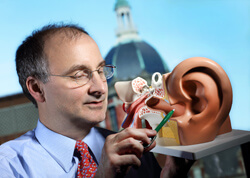
Although every physician practices medicine to diagnose and treat patients with the most benefit and least chance of harm, there can be a wide range of opinions on the best treatment for any given disease. That’s why major physicians’ organizations are developing clinical practice guidelines that use available evidence to issue action statements to improve quality and outcomes and reduce variations in practices, says David Tunkel, director of Johns Hopkins’ Division of Pediatric Otolaryngology. Recently, Tunkel joined otologists, pediatricians, nurse practitioners, audiologists and other specialists to produce new clinical practice guidelines on two common issues: how to treat acute otitis media and how to care for children who are candidates for tympanostomy tubes.
For acute otitis media, Tunkel joined a group convened by the American Academy of Pediatrics (AAP) to update guidelines last issued in 2004.
The new guidelines emphasize more precise diagnosis of acute otitis media when there is bulging of the tympanic membrane and tympanic membrane erythema in the appropriate clinical setting. Additionally, otitis media is not present in the absence of a middle ear effusion.
These guidelines further clarify when to treat acute otitis media with antibiotics, Tunkel says. When the condition is causing severe symptoms, is bilateral or is causing otorrhea, the document recommends treatment with antibiotics at the time of diagnosis. If these conditions aren’t in place, the guidelines suggest taking a wait-and-see approach in children over 2 years of age, with antibiotics used for symptoms that persist after two to three days. Very young children with acute otitis media should be treated with antibiotics at diagnosis.
The AAP guidelines suggest not prescribing prophylactic antibiotics for children with recurrent acute otitis media. They advise that clinicians may offer tympanostomy tubes if patients have frequent infections: three incidences of acute otitis media in the past six months, or four in the last year with at least one incidence in the last six months.
The second set of guidelines, issued by the American Academy of Otolaryngology?Head and Neck Surgery (AAOHNS), deals specifically with issues about tympanostomy tubes.
Adding to the AAP guidelines, those from the AAOHNS suggest that doctors offer tympanostomy tubes to children with recurrent acute otitis media only when middle ear fluid is seen in one or both ears at the time of evaluation, Tunkel says.
The AAOHNS guidelines urge identifying children who might have more substantial problems from ear infections or from the hearing loss associated with middle ear effusion: for example, children with speech and language delays, preexisting hearing loss, visual loss, Down syndrome or autism. Tubes are likely needed more often for children in this “at-risk” group who have middle ear disease.
The AAOHNS guidelines also recommend using antibiotic eardrops instead of oral medications to treat acute otorrhea in children with tympanostomy tubes. Additionally, routine water precautions are not necessary for most children who have tympanostomy tubes in place.
Tunkel notes that the advice in both guidelines is research-based and is usually backed by randomized, controlled trials and systematic reviews. These clinical practice guidelines use a defined guideline creation process that uses analysis of the evidence by experts from multiple disciplines.
“Third parties, not treating physicians, have a growing influence on how we choose diagnostic pathways and treatments,” he says, “so it’s really important that physicians take the lead in producing, understanding and implementing these evidence-based practices.”
For information: 443-997-6467
